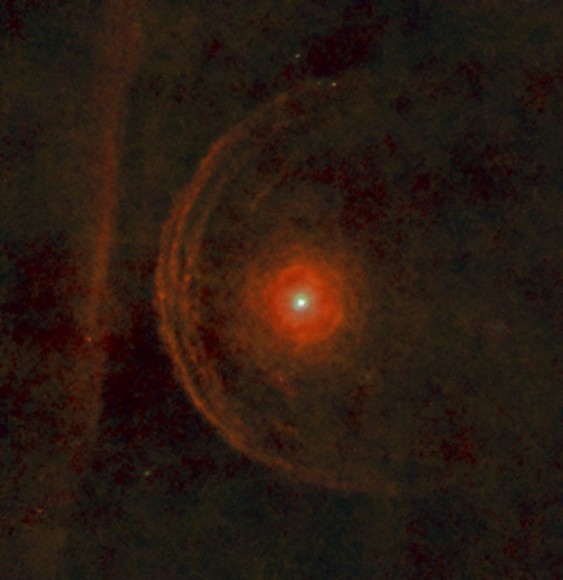
But look at Betelgeuse with a really powerful telescope, like the European Space Agency's Herschel telescope, and you'll see something like this: the red supergiant Betelgeuse in all its glory, smashing its ferocious solar winds into its environment.
In this photograph, just released from the European Space Agency, you can see the powerful solar winds creating a bow shock around the star as it ploughs through the interstellar medium at a speed of 30 km/s. Closer into the star there are asymmetric structures, where the star shed material in fits and starts into its surroundings, like convective bubbles randomly popping to the top of a pot of boiling water.
It's the interaction of this supergiant star and its surroundings that astronomers were attempting to unravel with their research, in a paper titled: The enigmatic nature of the circumstellar envelope and bow shock surrounding Betelgeuse as revealed by Herschel. Researchers from several European universities combined data from Herschel, the GALEX space observatory, WISE, and even radio wavelengths to study Betelgeuse and its environment. They studied the star, the bow shock, and the asymmetric clumps of material around it.
Over on the left-hand side of the photograph is a mysterious dusty wall structure that Betelgeuse is heading straight for. Because this dusty wall doesn't curve, like the bow shock around Betelgeuse, astronomers don't think it was caused by the star itself. According to the researchers:
Betelgeuse is, however, responsible for illuminating this structure, like a flashlight illuminating a nearby fog bank. And according the astronomer's calculations, the star's bow shock will collide with that wall in a mere 5,000 years, with the star itself following suit 12,500 years later.The linear bar might be the edge of an interstellar cloud illuminated by Betelgeuse or a linear filament whose a possible origin is linked to the Galactic magnetic field. Since no curvature is present in the bar, we believe that the bar is not directly linked to a previous blue supergiant wind
Source: ESA News Release



"linear bar" is actually convex.
It is another celestial sphere.
Times bigger than Betelgeuse's sphere.
This is the partner's star ( brown dwarf ) sphere.
Betelgeuse is "shrinking".
Will be changing it's color to yellow, pink, white, blue and back as any other star.
[Link]
It would become supernova when white, but only once per 12,5 turns around the partner star.
Possible Betelgeuse's double ( Betelgeuse B )
[Link]
In itself, it is also double ( Betelgeuse C )
[Link]
That is the reason for Betelgeuse's variability.